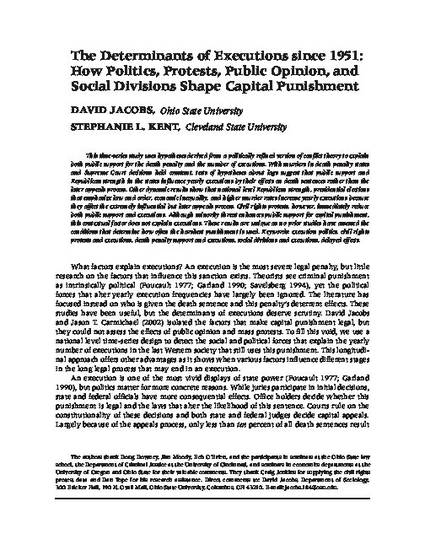Publication Date
8-1-2007
Abstract
This time-series study uses hypotheses derived from a politically refined version of conflict theory to explain both public support for the death penalty and the number of executions. With murders in death penalty states and Supreme Court decisions held constant, tests of hypotheses about lags suggest that public support and Republican strength in the states influence yearly executions by their effects on death sentences rather than the later appeals process. Other dynamic results show that national level Republican strength, presidential elections that emphasize law and order, economic inequality, and higher murder rates increase yearly executions because they affect the extremely influential but later appeals process. Civil rights protests, however, immediately reduce both public support and executions. Although minority threat enhances public support for capital punishment, this contextual factor does not explain executions. These results are unique as no prior studies have assessed the conditions that determine how often the harshest punishment is used.
DOI
10.1525/sp.2007.54.3.297
Publisher's Statement
Published as Jacobs, D. and Stephanie L. Kent. 2007. "The Determinants of Executions Since 1951: How Politics, Protests, Public Opinion, and Social Divisions Shape Capital Punishment."
Social Problems 54(3):297-318. © 2007 by the Regents of the University of California. Copying and permissions notice: Authorization to copy this content beyond fair use (as specified in Sections 107 and 108 of the U. S. Copyright Law) for internal or personal use, or the internal or personal use of specific clients, is granted by the Regents of the University of California for libraries and other users, provided that they are registered with and pay the specified fee via Rightslink® on JSTOR (http://www.jstor.org/r/ucal) or directly with the Copyright Clearance Center, http://www.copyright.com.
Citation Information
Jacobs, D. and Stephanie L. Kent. 2007. "The Determinants of Executions Since 1951: How Politics, Protests, Public Opinion, and Social Divisions Shape Capital Punishment."
Social Problems 54(3):297-318.

